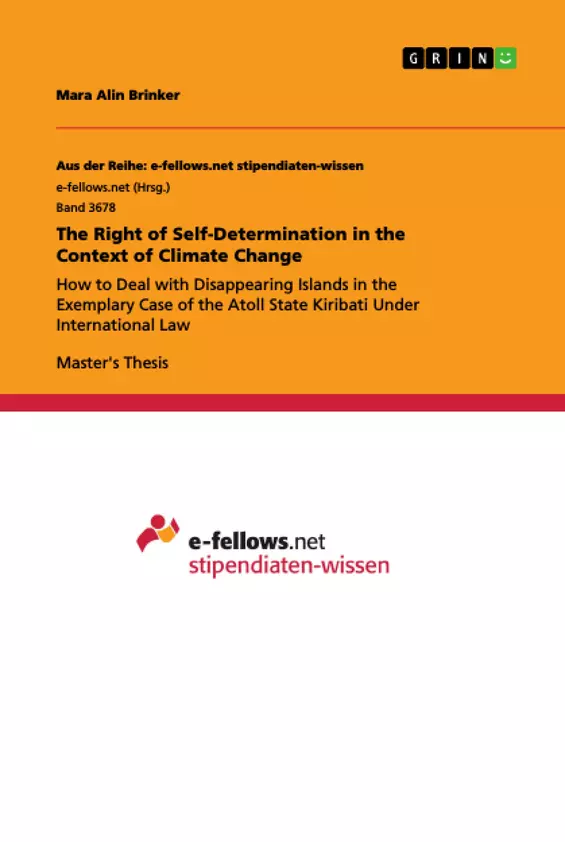What we only know from films and history, like the history of Atlantis from the ancient times, will become reality in the nearest future. In the South Pacific, one of the greatest inundations in the world's history threats including the loss of territory for various islands and, in the worst case, the loss of a whole Island State - of the low-lying coral atoll island State Kiribati. The question raises if there does not yet exist neither a migration plan nor an answer to the question, what happens with the State Kiribati when it will be inundated.
The cause for that phenomenon is one of the very present problems in the world's discussion: the Climate Change. "Climate Change is one of the greatest challenges of our time, and climate-effected hazards have direct and irreversible consequences on people, property, business, financial systems, and state institutions worldwide."
However, the phenomenon of the Climate Change is well-known nowadays, and material for discussion, the International Law offers only a few approaches and rarely solutions for the urgent threat. In this particular research project, it will be tried to resolve the question, how to define a State without territory if the territory will be inundated.
Inhaltsverzeichnis (Table of Contents)
- Introduction
- Chapter 1: The Right of Self-Determination
- Preliminary Words
- What is the Right of Self-Determination?
- Classification of the Right of Self-Determination
- The aims of the Right of Self-Determination
- Differentiation between Statehood and Self-Determination
- Statehood as an implementation of Self-Determination
- Definition of Statehood
- Conclusion
- Chapter 2: New Challenge for the Right of Self-Determination in the light of Climate Change
- Preliminary Words
- Inundations caused by Climate Change
- I-Kiribati recognized as "people"
- Inundations caused by Climate Change: A threat to Self-Determination
- The necessity of a legal rule concerning the atoll island populations
- The protection for the Self-Determination of I-Kiribati
- Conclusion
- Chapter 3: The existing Solutions: what offers the international Law to the “Disappearing Island States\"?
- Preliminary Words
- Planned Migration and cede of territory
- Does Displacement mean Migration?
- Ceding of Territory
- Theoretical Problems
- Practical problems
- Conclusion
- Is Statehood still necessary?: the retreat and other entities
- Right of Self-Determination in the context of the retreat of Statehood
- Free Association
- Federalism
- Other non-territorial autonomy arrangements
- The Retreat of Statehood as the solution?
- Conclusion
- Chapter 4: The innovative solution: The idea of the \"de-territorialized Nation-States\".
- Preliminary Words
- The minimum threshold account of Statehood
- Population
- Government
- Independence
- Territory
- Statelessness as unacceptable approach
- The de-territorialized Nation-State as a new shape of the international entity
- The Right of Self-Determination in de-territorialized States
- Conclusion
- Final remarks to the solutions
Zielsetzung und Themenschwerpunkte (Objectives and Key Themes)
This work aims to explore the implications of climate change on the right of self-determination, particularly in the case of the island state of Kiribati. It analyzes the challenges posed by rising sea levels and the potential for displacement and loss of territory, investigating the existing solutions offered by international law. The text also introduces a novel concept – the "de-territorialized nation-state" – as a potential solution for the unique circumstances faced by island states threatened by climate change. Key themes explored in this work include:- The right of self-determination in the context of climate change
- The challenges faced by island states due to rising sea levels
- The existing solutions offered by international law, such as planned migration and cession of territory
- The concept of the "de-territorialized nation-state" as a new solution for threatened island states
- The implications of climate change for statehood and the future of island nations
Zusammenfassung der Kapitel (Chapter Summaries)
Chapter 1: The Right of Self-Determination
This chapter provides a foundational overview of the right of self-determination, defining its core principles and exploring its classification and objectives. It distinguishes between self-determination and statehood, examining the latter as a potential implementation of the former.Chapter 2: New Challenge for the Right of Self-Determination in the light of Climate Change
This chapter focuses on the specific challenges posed by climate change to the right of self-determination, particularly for island states like Kiribati. It discusses the threats posed by inundations caused by rising sea levels and examines how these threats can be interpreted as violations of self-determination.Chapter 3: The existing Solutions: what offers the international Law to the “Disappearing Island States\"?
This chapter explores the existing legal solutions offered by international law for island states facing displacement and potential loss of territory due to climate change. It analyzes the feasibility of planned migration and cession of territory, while also considering alternatives to traditional statehood, such as free association and federalism.Chapter 4: The innovative solution: The idea of the \"de-territorialized Nation-States\".
This chapter introduces a new concept – the "de-territorialized nation-state" – as a potential solution for island states facing climate-related challenges. It argues that this model, based on a minimum threshold account of statehood, could offer a way for island states to maintain their national identity and self-determination even in the face of territorial loss.Schlüsselwörter (Keywords)
This work primarily focuses on the intersection of international law, climate change, and the right of self-determination, particularly in the context of island states threatened by rising sea levels. Key terms and concepts explored include climate change, self-determination, statehood, de-territorialized nation-state, displacement, inundations, migration, cession of territory, and legal solutions for island states facing climate-related challenges.- Arbeit zitieren
- Mara Alin Brinker (Autor:in), 2020, The Right of Self-Determination in the Context of Climate Change, München, GRIN Verlag, https://www.grin.com/document/920732



